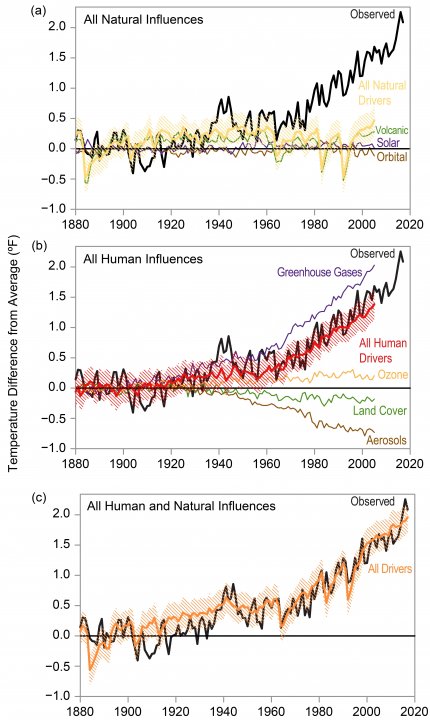Fourth National Climate Assessment, Volume II
Volume II of the Fourth National Climate Assessment (NCA4) has just recently been released. This is critical reading for anyone concerned about the future of our planet and the future of humanity. Here is a link to Chapter 1: Overview. Volume I, Climate Science Special Report (CSSR) was published in 2017 and provides the scientific basis for the observed and projected risks and impacts of climate change now and in the coming years as discussed in Volume II. A summary of the CSSR is provided in Chapter 2 of Volume II.

Key Message #1 from Volume II:
Global climate is changing rapidly compared to the pace of natural variations in climate that have occurred throughout Earth’s history. Global average temperature has increased by about 1.8°F from 1901 to 2016, and observational evidence does not support any credible natural explanations for this amount of warming; instead, the evidence consistently points to human activities, especially emissions of greenhouse or heat-trapping gases, as the dominant cause.
The Global Change Research Act mandates that the U.S. Global Change Research Program (USGCRP) provide a NCA report to Congress and the President no less than every four years. It is important to understand who generates this report and the process that is followed for researching, writing, editing, and reviewing. From the "About This Report" section of Volume II:
The National Oceanic and Atmospheric Administration (NOAA) served as the administrative lead agency for the preparation of this report. A Federal Steering Committee, composed of representatives from USGCRP agencies, oversaw the report’s development.
ore than 300 federal and non-federal experts—including individuals from federal, state, and local governments, tribes and Indigenous communities, national laboratories, universities, and the private sector—volunteered their time to produce the assessment, with input from external stakeholders at each stage of the process. A series of regional engagement workshops reached more than 1,000 individuals in over 40 cities, while listening sessions, webinars, and public comment periods provided valuable input to the authors. Participants included decision-makers from the public and private sectors, resource and environmental managers, scientists, educators, representatives from businesses and nongovernmental organizations, and the interested public.
NCA4 Volume II was thoroughly reviewed by external experts and the general public, as well as the Federal Government (that is, the NCA4 Federal Steering Committee and several rounds of technical and policy review by the 13 federal agencies of the USGCRP). An expert external peer review of the whole report was performed by an ad hoc committee of the National Academies of Sciences, Engineering, and Medicine (NASEM).3 Additional information on the development of this assessment can be found in Appendix 1: Report Development Process.